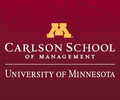
5 Questions with Molly Rice

Molly Rice is the CEO and majority owner of Minneapolis-based Spyglass Brand Marketing, which she co-founded in 2001. Molly has 25+ years of experience in creating and implementing award-winning marketing and customer experience strategies for leading B2B companies around the world. She has successfully opened and managed agency offices in the US, Europe and Australia while managing complex projects and client teams in more than 15 countries.
Molly will be speaking at MN AMA's event, B2B Brand Strategy: What is it and where do I start?, on June 14. Molly will share Spyglass’ approach for Walman's recent brand strategy in 2015 which won a Platinum International Marcomm Award.
We asked Molly five questions about B2B brand marketing.
- How do you determine a company’s “secret sauce” in order to help them re-brand? Are you looking only for a decline in sales to determine the need for re-branding?
More often than not, a brand’s secret sauce is not contained in the marketing they use to talk about themselves, but in the words, phrases and insights we hear during interviews with their key stakeholders and customers, albeit these are often in a coded way that lack a certain coherency. That’s where we come in – we take the power of the WHY someone is doing business with a company and translate that into a premise, an idea, an emotion that is simple, compelling, memorable and proprietary so it helps to clearly, quickly and properly position the company and spark the right connections and lead to the right conversations. We also help companies understand the white space that exists in their industry by looking closely at what the competition is doing and saying. Our job, and the skill we’ve honed over the years with hundreds of clients is to bring to the table the right strategic positioning options, key messages, creative ideas and sales/marketing assets that will give a company their best opportunity to tell their story in a way that connects with customers/prospects, engages their internal team and equips their sales team to tell it effectively so they can achieve their business goals.
- How does your approach differ in branding a B2B company versus a B2C company?
Today, B2B is becoming more B2C than ever. Like any B2C brand strategy or marketing campaign that delivers results, B2B “selling” requires a highly-targeted message and the requisite personality and energy to make it break through, feel genuine, timely and exactly what your audience has been looking for to make their life easier, make them look good and help them succeed. A key target audience that many companies often overlook when developing their brand or marketing is their own people – the engagement, understanding and buy-in of internal stakeholders are all critical in order to leverage your investment in any external efforts. Our mantra is: Get Your Story Straight, Align and Engage Your Internal Team, Deliver on Your Customer Experience, and then Spread the News – preferably in that order. Many B2B companies jump to “spreading the news” without really doing the first three so we help them take a more holistic view of what they need to do in all of these areas and then zero in on the gaps and focus our efforts there.
- Re-branding sometimes goes deeper than marketing - like in the case of Reeher, which needed a full-scale organizational overhaul to pump up functionality as well as garner new customers. How do you determine what elements need re-branding? What resources do you bring to the table to ensure success?
Every brand works through a lot of different channels to engage and convert prospects. It’s unique to each client. B2B is typically done best when highly-targeted to a key audience. Many B2B companies, especially professional services, are often selling people or trust, which is experiential and hard to do and you have to prove you're worth the investment in a long-term partnership – not just selling a product or service. Reeher serves a specialized subset in higher education. They were beginning to build an impressive cache of noteworthy colleges, but were having a hard time bringing more on board even with a credible client list. What we did for them, as we do with all of our clients, is to put ourselves in the shoes of their customer which changed Reeher’s pitch from one that talked about their “technology that helps you fundraise better” to positioning their solution as “a faster way to fundraising”. It seems subtle but it’s very profound. Their target audience cared about speed to better fundraising, not the technology to help them do it. Once Reeher put themselves out there as the faster way for higher education institutions to raise more fundraising dollars, they almost doubled their client list within 12 months, including marquee institutions.
The other important aspect was pushing the idea of Reeher as a thought leader in this space and push them to the front of the pack as the premiere experts in this category. We helped them launch exclusive customer events that were fun, allowed for networking and provided valuable peer benchmarking and other insights that higher education VPs wanted.
- When working with Walman, some of the companies they had acquired had their own brand awareness and loyalty. How do you determine if the greatest strength is in rebranding all of the acquisitions to fall under one name, or leaving it as is in order to capitalize on the awareness? For instance, with Imagewear the name remained, but the logo changed to associate with the Walman brand.
In the end, it’s a highly collaborative process with the client. Walman is a great example of providing the right brand strategy options to them so they could understand the landscape and the impact that “rolling up” or “not rolling up” would have on their long- term business goals and brand positioning. Ultimately they choose to not roll up all of the sub-brands under one name as Walman, but to roll up visually by associating the sub-brand logos to the Walman master brand logo. That way the sub-brands could remain somewhat independent in terms of selling, but also be associated with the one hundred years of goodwill Walman had earned through a history of outstanding service and dedication to making their customers successful. We provided three strong branding and positioning options with defined “whys” and “why nots”. We shortened the master brand name to Walman (from Walman Optical) and crystalized six core Walman principles that represented how Walman guided each company it owned. This made it made it easier for Imagewear customers, for example, to understand they were doing business with an optical frame company that is guided by a larger, stable and dedicated ophthalmic company who has been a trusted partner in the eye care industry for over 100 years.
- How did you go from majoring in English Lit & Classics, to founding and leading a nationally recognized marketing firm?
I realized early on that I may not write the great American novel, but I could help some great American companies. The entrepreneurs and business people we work with are some of the most creative minds in the world. They have great ideas, vision and bring products and services to the market that literally change the world and fuel the economy – and they all have a great story to tell. I love working with my team to bring our clients’ stories to life and help businesses reach and engage a larger audience. It’s similar to a good novel. You just have shorten the storyline and equip all the players to do the stage version of the bestseller so that it delights a very defined and discerning audience.
Image courtesy of Spyglass Creative.






